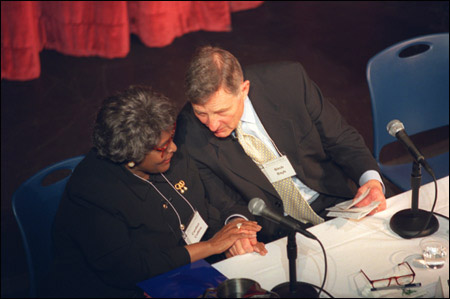Title bout over Title IX at Radcliffe:
Panel discussion at Agassiz Theater sparks strenuous disagreement

Ever since the landmark law became a talking point for the Bush administration, Title IX – some 30 years after its passage – is big news, all over again. In the current debate surrounding the 1972 piece of legislation that bans sexual discrimination in athletic programs receiving federal aid, both critics and proponents of Title IX share a surprising amount of common ground when it comes to the law’s fundamental intent. After all, one would be hard pressed to defend the exclusion of anyone from athletic participation. Or to dismiss the explosion of women’s participation in college sports – a 400 percent increase since President Nixon was in office – as anything less than revolutionary.
Where things gets heated, as demonstrated at this past Friday’s (May 16) panel discussion at Agassiz Theater, “The Future of Title IX,” presented by the Radcliffe Institute for Advanced Study, is around the law’s impact – imagined or otherwise – on men’s programs. Since 1981, detractors of the law point out, more than 400 so-called “minor men’s sports,” such as swimming and wrestling, have been eliminated in order that schools meet the proportionality requirement of the law. As one of the most widely used keys to Title IX compliance, this requirement states that athletic aid must be proportionate – give or take 2 to 3 percent – to the school’s ratio of male and female students.
Critics charge this condition of the law as being nothing less than a quota scheme. Title IX backers, on the other hand, blame the elimination of certain programs on poor budgeting practices by the school’s individual athletic departments, or more specifically, bloated football and basketball funding.
And though cool heads prevailed at Friday’s conference, Title IX is once again a source of frustration for opponents and supporters alike, as well as a springboard to examine the sweeping social changes concerning gender and sports.
“Do you want your daughters to have fewer opportunities than your sons?” asked former senator from Indiana Birch E. Bayh, the architect of the original Title IX legislation and one of the eight panelists who gathered on Friday afternoon. Comparing the passage of Title IX to the Civil Rights Act and Voting Rights Act of the mid-60s, Bayh commented, “We’re still battling for equality.”
“When we spend $2 for boys’ sports, and $1 for girls’ sports, there’s still discrimination,” said Bayh, calling this discrepancy proof of “unfinished business.”
Christine Grant, associate professor of sports administration at the University of Iowa and an expert consultant for the Civil Rights Title IX Task Force, also reported and decried the inequity in resources, noting that women annually receive $133 million less in athletic scholarships than men.
Sharing the stage with Grant was Mike Moyer, the executive director of the National Wrestling Coaching Association. Applauding Title IX’s function, Moyer – whose association in 2002 filed a high-profile lawsuit against the Department of Education’s Office for Civil Rights, the body that governs Title IX – was critical of the proportionality aspect of the law. Comparing it with quotas, Moyer asked his counterpart, “What’s the difference?”
In the eyes of the law, quite a bit, apparently, as the Justice Department dismissed the case, reasoning that schools, not the federal government, must remedy discrimination – a stance that continues to hinder the legal efforts of Title IX opponents.
As for the law’s proponents, Bayh summed up his convictions with an anecdote regarding his father’s testimony before a congressional committee in support of physical education programs for young women. Relaying his father’s reasoning for such a bold plan, Bayh, getting a little choked up, quoted his father: “Little girls need strong bodies to carry their heads around on.”




